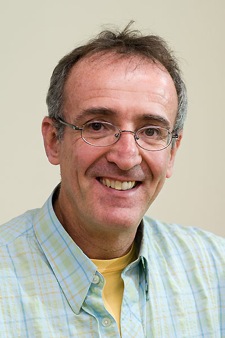For plastics knowledge, India looks to UW-Madison engineers
One of the oldest and most respected polymer engineering research and educational programs in the United States is contributing its expertise to a new plastics university in India.
Representatives of the University of Wisconsin–Madison Polymer Engineering Center signed a memorandum of understanding in Dehli, India, this month with the PlastIndia Foundation and the University of Massachusetts, Lowell.
The three entities will collaborate to develop curriculum for the PlastIndia International University, an institution dedicated to plastics research, higher education, management and entrepreneurship.
Expected to break ground later in 2012 and open within three years, the new university will be located in Vapi in the state of Gujarat, one of the largest plastics manufacturing regions in India.

Osswald
Both Massachusetts and UW–Madison are well positioned to contribute to the effort, says plastics expert Tim Osswald, the Kuo K. and Cindy F. Wang professor of mechanical engineering at UW–Madison.
“U-Mass, Lowell, has a whole undergrad program dedicated to plastics engineering, while UW–Madison is well-known for its industry partnerships, leading-edge research and plastics courses integrated into our mechanical engineering degree program,” he says.
The plastics industry is among the fastest growing industries in India. Currently, about 4 percent of the world’s plastics products are produced in India-and the industry is growing at approximately 12 percent each year.
The PlastIndia Foundation, India’s largest plastics trade association, recognized that growth, says Osswald.
“One of the major bottlenecks is that they don’t produce enough plastics engineers,” he says. “So, they decided to create a university that will actually produce plastics engineers. And they needed help from schools that have experience teaching and doing research in plastics.”
The PlastIndia Foundation sought that expertise from U-Mass, Lowell, and UW–Madison, says Bipin M. Shah, vice president of the PlastIndia Foundation.
As a chemical engineer trained in plastic processing in the United States, Shah was exposed to the landmark 1960 textbook, “Transport Phenomena,” authored by UW–Madison chemical engineers R. Byron Bird, Warren Stewart and Edwin Lightfoot.
“The contributions by your esteemed university in the field of polymer engineering are second to none,” says Shah. “Thus, we selected UW–Madison. India needs education from very pre-emminent scholars for continuous growth, where hands-on training as well as processing knowledge of polymers is a must. [UW-Madison], as well as U-Mass, Lowell, would be a very complimentary combination.”
At UW–Madison, plastics science and engineering dates back to 1946, when mechanical engineer Ron Daggett began teaching plastics processes courses. At the same time, John Ferry, a chemistry professor at the university, made key research contributions in polymer physics, while chemical engineer Bird linked the two fields with fundamental discoveries in polymer fluid dynamics and rheology.
Today, the UW–Madison plastics faculty includes international experts in plastics rheology, injection molding, moldless manufacturing techniques, plastics simulation, and biomedical applications for plastics, among others.
Through the Polymer Engineering Center Industrial Consortium, UW–Madison polymer engineers collaborate closely with industry partners ranging from multinational companies to Wisconsin businesses such as Phillips Plastics Corp. of Hudson, Bemis Manufacturing of Sheboygan Falls and Extrusion Dies Industries of Chippewa Falls.
“We’ve always kept our eye on industry and know the industry’s needs,” says Osswald.
“A really important aspect of our education here is to create graduates who can think globally. And that’s going to be beneficial to our industry and our economy.”
Tim Osswald
Many of those local and international companies have their roots in plastics undergraduate and graduate education at UW–Madison, where faculty literally wrote the accepted textbooks in use worldwide on polymer engineering.
Osswald alone is author of 12 books, among them “Materials Science of Polymers for Engineers,” “Understanding Polymer Processing,” and the “International Plastics Handbook” and the polymer engineering faculty use technologies such as video and podcasting to meet students’ educational needs.
In addition, UW–Madison students learn about plastics and put that knowledge to the test in an operational polymer laboratory that houses more than a dozen state-of-the-art polymer-processing machines.
“We have 100 kids coming out of the Department of Mechanical Engineering every semester who understand plastics-and that’s unique,” says Osswald. “Not many schools have that.”
The partnership with PlastIndia International University will include an exchange program for both faculty and students. As a result, says Osswald, UW–Madison graduates will enter the profession knowing how the plastics industry in India works.
“A really important aspect of our education here is to create graduates who can think globally,” he says. “And that’s going to be beneficial to our industry and our economy.”
Rather than view the Indian plastics industry as competition, a variety of U.S. industries could support and benefit from its growth, says Osswald. While one barrier India faces is the lack of plastics engineers, it also must replace outdated equipment, operate manufacturing facilities in environmentally sustainable ways, and generate enough energy to fuel the industry as a whole.
U.S. industry is poised to provide India technology in all of these areas. In Wisconsin-home to a thriving plastics industry-Extrusion Dies Industries, for example, is a global leader in manufacturing flat extrusion dies for film for packaging, while RTP Co. of Winona, Minn., develops specialty polymer compounds for applications ranging from electronics and appliances to medical, sports and automotive.
In fact, both companies were exhibitors at the PlastIndia 2012 international plastics exhibition and conference when the U.S. and Indian collaborators signed the memorandum of understanding.
“There’s going to be business on both sides,” says Osswald. “We will benefit from India having a strong plastics industry.”
